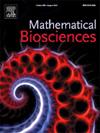在基于3-D药物的纤维化模型中,纤维化细胞外基质优先诱导部分上皮-间质转化表型。
IF 1.9
4区 数学
Q2 BIOLOGY
引用次数: 0
摘要
纤维化疾病的主要驱动因素之一是上皮-间质转化(EMT):细胞经历从上皮状态到亲迁移状态的表型变化的转分化过程。细胞因子转化生长因子-β1 (TGF-β1)先前已被证明可调节EMT。TGF-β1结合纤维连接蛋白(FN)原纤维,是肾纤维化的主要细胞外基质(ECM)成分。我们之前已经通过实验证明,抑制FN纤维形成和/或TGF-β1粘附在FN上可抑制EMT。然而,这些研究仅在二维细胞单层上进行,TGF-β1-FN系固在三维细胞环境中的作用尚不清楚。因此,我们试图开发上皮球体的三维计算模型,以捕获EMT信号动力学和TGF-β1-FN系固动力学。我们将Tian等人(2013)开发的双稳态EMT开关模型纳入到三维多细胞模型中,以捕获TGF-β1信号的时空动态。我们发现,增加外源TGF-β1浓度的加入导致EMT进展更快,表现为间充质标志物表达增加,细胞增殖减少,迁移增加。然后,我们通过局部降低TGF-β1扩散系数作为EMT的函数,将TGF-β1拴在FN原纤维上,模拟TGF-β1在纤维化过程中拴在FN原纤维上时减少的运动。我们发现TGF-β1与FN原纤维的结合促进了部分EMT状态,不依赖于外源性TGF-β1浓度,这表明纤维化ECM可以促进部分EMT状态的机制。本文章由计算机程序翻译,如有差异,请以英文原文为准。
Fibrotic extracellular matrix preferentially induces a partial Epithelial–Mesenchymal Transition phenotype in a 3-D agent based model of fibrosis
One of the main drivers of fibrotic diseases is epithelial–mesenchymal transition (EMT): a transdifferentiation process in which cells undergo a phenotypic change from an epithelial state to a pro-migratory state. The cytokine transforming growth factor-1 (TGF-1) has been previously shown to regulate EMT. TGF-1 binds to fibronectin (FN) fibrils, which are the primary extracellular matrix (ECM) component in renal fibrosis. We have previously demonstrated experimentally that inhibition of FN fibrillogenesis and/or TGF-1 tethering to FN inhibits EMT. However, these studies have only been conducted on 2-D cell monolayers, and the role of TGF-1-FN tethering in 3-D cellular environments is not clear. As such, we sought to develop a 3-D computational model of epithelial spheroids that captured both EMT signaling dynamics and TGF-1-FN tethering dynamics. We have incorporated the bi-stable EMT switch model developed by Tian et al. (2013) into a 3-D multicellular model to capture both temporal and spatial TGF-1 signaling dynamics. We showed that the addition of increasing concentrations of exogeneous TGF-1 led to faster EMT progression, indicated by increased expression of mesenchymal markers, decreased cell proliferation and increased migration. We then incorporated TGF-1-FN fibril tethering by locally reducing the TGF-1 diffusion coefficient as a function of EMT to simulate the reduced movement of TGF-1 when tethered to FN fibrils during fibrosis. We showed that incorporation of TGF-1 tethering to FN fibrils promoted a partial EMT state, independent of exogenous TGF-1 concentration, indicating a mechanism by which fibrotic ECM can promote a partial EMT state.
求助全文
通过发布文献求助,成功后即可免费获取论文全文。
去求助
来源期刊

Mathematical Biosciences
生物-生物学
CiteScore
7.50
自引率
2.30%
发文量
67
审稿时长
18 days
期刊介绍:
Mathematical Biosciences publishes work providing new concepts or new understanding of biological systems using mathematical models, or methodological articles likely to find application to multiple biological systems. Papers are expected to present a major research finding of broad significance for the biological sciences, or mathematical biology. Mathematical Biosciences welcomes original research articles, letters, reviews and perspectives.
 求助内容:
求助内容: 应助结果提醒方式:
应助结果提醒方式:


